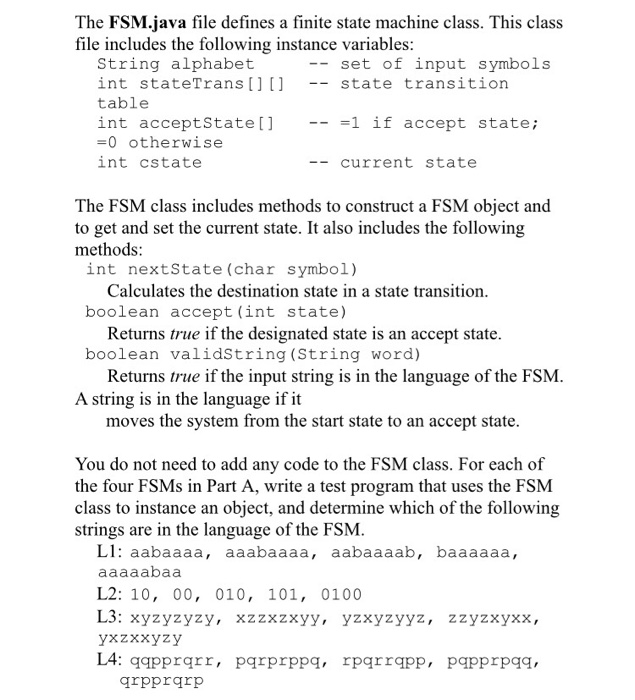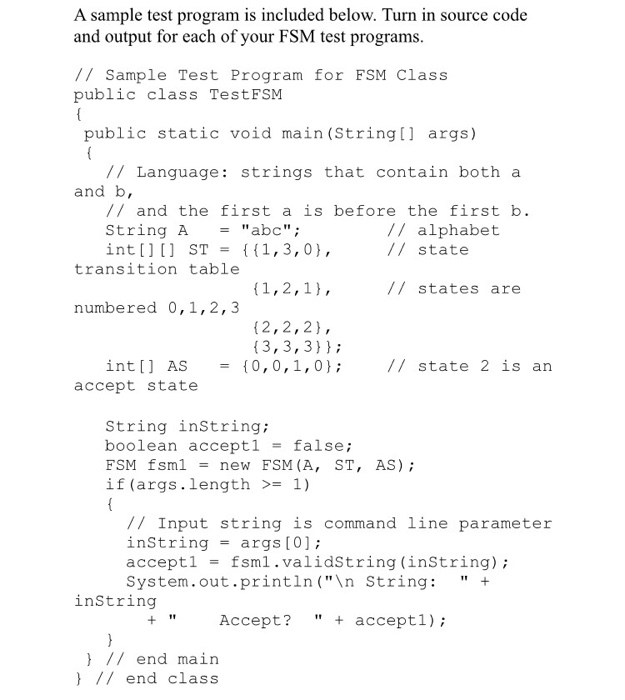Answered step by step
Verified Expert Solution
Question
1 Approved Answer
// Finite State Machine Class public class FSM { // Instance variables public String alphabet; public int stateTrans[][]; public int acceptState[]; private int cstate; //
// Finite State Machine Class
public class FSM
{
// Instance variables
public String alphabet;
public int stateTrans[][];
public int acceptState[];
private int cstate;
// Constructor function
public FSM(String A, int[][] ST, int[] AS)
{
int NSYMBOLS = A.length();
int NSTATES = AS.length;
// Alphabet
alphabet = "" + A;
// State transition table
stateTrans = new int[NSTATES][NSYMBOLS];
for(int r = 0; r
for(int c = 0; c
stateTrans[r][c] = ST[r][c];
// Accept states
acceptState = new int[NSTATES];
for(int r = 0; r
acceptState[r] = AS[r];
// Start state
cstate = 0;
}
// Methods
public int getState()
{
return cstate;
}
public void setState(int state)
{
cstate = state;
return;
}
public int nextState(char symbol)
{
int nstate = -1;
int col = alphabet.indexOf(symbol);
if(col >= 0)
nstate = stateTrans[cstate][col];
return nstate;
}
public boolean accept(int state)
{
if(state
return false;
return (acceptState[state] != 0);
}
public boolean validString(String word)
{
cstate = 0;
for(int k = 0; k
cstate = nextState(word.charAt(k));
if(cstate 

The FSM java file defines a finite state machine class. This class file includes the following instance variables: String alphabet set of input symbols int state Trans state transition table -1 if accept state int accept State 0 otherwise int cstate Current State The FSM class includes methods to construct a FSM object and to get and set the current state. It also includes the following methods: int next State (char symbol) Calculates the destination state in a state transition. boolean accept (int state) Returns true if the designated state is an accept state. boolean validstring (String word) Returns true if the input string is in the language of the FSM A string is in the language if it moves the system from the start state to an accept state. You do not need to add any code to the FSM class. For each of the four FSMs in Part A, write a test program that uses the FSM class to instance an object, and determine which of the following strings are in the language of the FSM. LI: aabaaaa aaaba aaa aabaa aab baaaaaa, aaaaabaa 12: 10, 00, 010 101, 0100 L3: xyzyzyzy xzzxzxyy, yzxyzyyz, z zyzxyxx, LA: qapprarr, parprppa, rparrapp, papprpqq, grpprgrp return false;
}
return accept(cstate);
}
} // end class


Step by Step Solution
There are 3 Steps involved in it
Step: 1

Get Instant Access to Expert-Tailored Solutions
See step-by-step solutions with expert insights and AI powered tools for academic success
Step: 2

Step: 3

Ace Your Homework with AI
Get the answers you need in no time with our AI-driven, step-by-step assistance
Get Started


